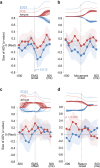Presynaptic gating of monkey proprioceptive signals for proper motor action
- PMID: 37880215
- PMCID: PMC10600222
- DOI: 10.1038/s41467-023-42077-w
Presynaptic gating of monkey proprioceptive signals for proper motor action
Abstract
Our rich behavioural repertoire is supported by complicated synaptic connectivity in the central nervous system, which must be modulated to prevent behavioural control from being overwhelmed. For this modulation, presynaptic inhibition is an efficient mechanism because it can gate specific synaptic input without interfering with main circuit operations. Previously, we reported the task-dependent presynaptic inhibition of the cutaneous afferent input to the spinal cord in behaving monkeys. Here, we report presynaptic inhibition of the proprioceptive afferent input. We found that the input from shortened muscles is transiently facilitated, whereas that from lengthened muscles is persistently reduced. This presynaptic inhibition could be generated by cortical signals because it started before movement onset, and its size was correlated with the performance of stable motor output. Our findings demonstrate that presynaptic inhibition acts as a dynamic filter of proprioceptive signals, enabling the integration of task-relevant signals into spinal circuits.
© 2023. Springer Nature Limited.
Conflict of interest statement
The authors declare no competing interests.
Figures







Similar articles
-
Early postnatal development of GABAergic presynaptic inhibition of Ia proprioceptive afferent connections in mouse spinal cord.J Neurophysiol. 2013 Apr;109(8):2118-28. doi: 10.1152/jn.00783.2012. Epub 2013 Jan 23. J Neurophysiol. 2013. PMID: 23343895 Free PMC article.
-
Nerve-Specific Input Modulation to Spinal Neurons during a Motor Task in the Monkey.J Neurosci. 2017 Mar 8;37(10):2612-2626. doi: 10.1523/JNEUROSCI.2561-16.2017. Epub 2017 Feb 3. J Neurosci. 2017. PMID: 28159911 Free PMC article.
-
Roles of primate spinal interneurons in preparation and execution of voluntary hand movement.Brain Res Brain Res Rev. 2002 Oct;40(1-3):53-65. doi: 10.1016/s0165-0173(02)00188-1. Brain Res Brain Res Rev. 2002. PMID: 12589906 Review.
-
Sensory input to primate spinal cord is presynaptically inhibited during voluntary movement.Nat Neurosci. 2003 Dec;6(12):1309-16. doi: 10.1038/nn1154. Epub 2003 Nov 16. Nat Neurosci. 2003. PMID: 14625555
-
Proprioception: Bottom-up directive for motor recovery after spinal cord injury.Neurosci Res. 2020 May;154:1-8. doi: 10.1016/j.neures.2019.07.005. Epub 2019 Jul 20. Neurosci Res. 2020. PMID: 31336141 Review.
Cited by
-
Topographical and cell type-specific connectivity of rostral and caudal forelimb corticospinal neuron populations.Cell Rep. 2024 Apr 23;43(4):113993. doi: 10.1016/j.celrep.2024.113993. Epub 2024 Mar 27. Cell Rep. 2024. PMID: 38551963 Free PMC article.
-
Presynaptic inhibition selectively suppresses leg proprioception in behaving Drosophila.bioRxiv [Preprint]. 2024 May 11:2023.10.20.563322. doi: 10.1101/2023.10.20.563322. bioRxiv. 2024. PMID: 37961558 Free PMC article. Preprint.
-
Future spinal reflex is embedded in primary motor cortex output.Sci Adv. 2024 Dec 20;10(51):eadq4194. doi: 10.1126/sciadv.adq4194. Epub 2024 Dec 18. Sci Adv. 2024. PMID: 39693430 Free PMC article.
References
Publication types
MeSH terms
LinkOut - more resources
Full Text Sources
Medical

